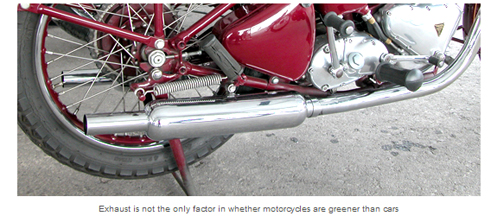Examiner Resurrection: How Green Is Your Motorcycle?
This is an interesting Examiner Resurrection because on checking I see that while I mentioned on this blog that I was doing a piece about this topic, I never fully dug into the topic here. I just posted links to the piece on Examiner. It’s all still totally relevant so I’m pleased to put the info up here now.
How Green Is Your Motorcycle?
How many times have you been out on your motorcycle and seen some behemoth, like a Hummer, cruising along with one person inside, and reflected smugly on how much better you were treating Mother Earth than that person?
Well here’s a news flash: You may not be as green as you think you are.
What’s that? It doesn’t take anywhere near as much iron and steel and plastic to make a motorcycle as it does a car, and we get a lot better gas mileage, too, unless that car is a Prius or something of that sort. How can we not be greener?
The fact is, there’s more to this issue than you might assume. This first article on the subject is an introduction to the general discussion and I’ll be digging deeper in later pieces.
Different Pollutants
Arguments have been made in some quarters that motorcycles in fact are worse polluters than cars. This contention is based primarily on differences in tailpipe emissions. Cars are equipped with catalytic converters, while most motorcycles are not. The result is that motorcycles emit more hydrocarbons, the stuff that causes smog, because their fuel is not burned as completely.
Here’s what the World Carfree Network has to say about it.
What is left out of this flawed reasoning is the fact that these engines are less developed, so that less fuel consumption cannot be translated directly into less pollution. . . . So, motorcycles do pollute more on some pollutants (like unburned hydrocarbons) and probably less on some others. The more that can be said is that they pollute in a different manner, but certainly not that they pollute less. . . . Despite the widespread view that motorcycle use is (at least) less noxious than car use, the truth is that they may be even more disastrous than cars.
By the way, just to be clear on where biases lie, the World Carfree Network describes itself saying, “World Carfree Network brings together organisations and individuals dedicated to promoting alternatives to car dependence and automobile-based planning at the international level and working to reduce the human impact on the natural environment while improving the quality of life for all.”
Less Of Everything Else
The opposing argument is based primarily on what appears to be the no-brainer aspects of the equation: Less materials to build motorcycles, less fuel to run them, less space to park them, less damage to the roads due their lighter weight, and on and on. Plus, in regard to pollutants, because motorcycles in general use less gasoline than cars, they do emit less carbon dioxide, the chief culprit alleged to be responsible for global warming, or climate change.
Ty Van Hooydonk addressed this question last fall at the Motorcycle Industry Council Symposium, in a presentation titled “Ride Green? Why Not? The Environmental Case for Motorcycles.” Recapping his presentation in an email to me, Ty spoke about comparing cars and motorcycles, saying:
How much energy does it take to produce each one? How much in the way of materials? How much of the materials are recyclable? How much is toxic in some way? Then let’s get to shipping the product to the dealership. How much energy (and this can relate to space on board a ship or inside a truck) does it require to get the vehicle to market? Then let’s get to actual use by the owner. With an equal number of miles driven/ridden, what’s the fuel economy? What are the total emissions? Out the tail-pipe and otherwise? How much in the way of oil and other chemicals are going in and out of each vehicle? Engine oil generally should be changed at same mileage intervals for both cars and bikes, so quantity may matter more here.
Ty also notes that, “In California, a big state for motorcycling, and in many other places around the world, motorcycles are allowed to lane-share and filter through clogged car traffic. That means that instead of sitting there idling away, burning fuel and polluting the air without getting anywhere, a motorcycle is almost always getting its rider somewhere, and sooner, too.”
Again, let’s lay the biases out clearly. Ty is the Communications Director with the Motorcycle Industry Council. These are the people whose businesses and livelihoods are based on the manufacture and sale of motorcycles and accessories.
Who Is Right?
So which is it? Are motorcycles greener than cars or are they not? The short answer is that no one can really say for sure, at least not with the incomplete understanding we currently have of the way all these factors inter-relate. In later articles I’ll dig deeper into some of these arguments and look at some tools that have been developed to try to answer some of these questions.
But nothing short of a full-blown scientific/statistical investigation by some disinterested third party is likely to provide a concrete yes or no answer to the basic question. And that investigation does not appear to be on anyone’s priority list at this time.
Biker Quote for Today
The two best feelings in the world are sex and riding a motorcycle.


January 11th, 2018 at 1:38 pm
Always a “fun” topic to bat around, Ken!
The engineering challenge in making motorcycle combustion engines emit less carbon monoxide, hydrocarbons and nitric oxides is one of safety and packaging. The dual catalyst design used on most cars today locates one catalyst right at the header of the engine, and it operates at a very high temperature. Under a hood, insulated by thermal blanketing, it packages well in a car.
It’s not so easy to do on a motorcycle, where the engine exhaust sits very close to the rider’s legs, and is also an integral part of a bike’s aesthetic design. It becomes a significant challenge for engineers because most motorcycle designs are minimalist in nature.
Apply time, effort and money and solutions can emerge, but the end result will add significant expense to the cost of a given bike — of which numerous models are produced in very low volume compared to the relative handful of automobile models. Also it may not be easily marketed to riders who place a high value on being able to see the engine and exhaust system and how they integrate into the overall look of a bike.
Environmental plusses for motorcycles continue to be comparatively good fuel economy, ease of parking, reduced traffic congestion and lower impact on roads & infrastructure.
We haven’t talked about electric bikes yet, and of course, who can forget all 2-wheeelers are just plain fun to ride!